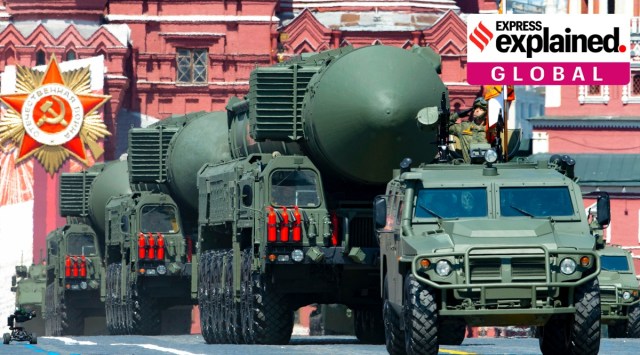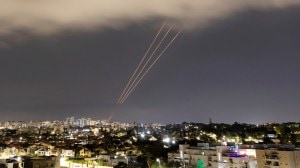- India
- International
With Putin’s nuclear threat, what are Russia’s ‘strategic’ and ‘tactical’ nuclear weapons?
Speculation over Putin’s next move in terms of weaponry has begun, with the terms 'tactical' and 'strategic' nuclear weapons making the rounds. We explain what these weapons are.
 Russian RS-24 Yars ballistic missiles roll in Red Square during the Victory Day military parade in Moscow, Russia in June 2020. (AP Photo, File)
Russian RS-24 Yars ballistic missiles roll in Red Square during the Victory Day military parade in Moscow, Russia in June 2020. (AP Photo, File)In a video address on September 21, Russia’s President Vladimir Putin signalled to his country that efforts in the ongoing war with Ukraine would be intensified, as reports of Ukrainian forces’ revival on the battlefield came in the last few weeks. Significantly, Putin said, “In the event of a threat to the territorial integrity of our country and to defend Russia and our people, we will certainly make use of all weapon systems available to us. This is not a bluff.”
The declaration was accompanied by claims that the West was using “nuclear blackmail” against Russia, where Putin referred to “Western-encouraged shelling of the Zaporozhye Nuclear Power Plant, which poses a threat of a nuclear disaster” and “the statements made by some high-ranking representatives of the leading NATO countries on the possibility and admissibility of using weapons of mass destruction – nuclear weapons – against Russia.”
As a result, there has been heightened speculation over what Putin’s next move might be in terms of weaponry. The terms “tactical” and “strategic” nuclear weapons have been making the rounds in this context.
The difference between tactical and strategic nuclear weapons
In the general scheme of things, strategic objectives are the interests of a particular country. But when it comes to nuclear weapons, strategic nuclear weapons are understood to mean those causing greater, large-scale damage. Tactical nuclear weapons, whereas, are small nuclear warheads and delivery systems meant to carry out a limited strike in a smaller area.
The smallest tactical nuclear weapons can be “one kiloton or less (producing the equivalent to a thousand tonnes of the explosive TNT). The largest can be as big as 100 kilotons. Strategic nuclear weapons are larger (up to 1,000 kilotons) and are launched from longer range. By comparison, the atomic bomb the US dropped on Hiroshima in 1945 was 15 kilotons”, as per a BBC report.

By this classification, the Hiroshima bomb would likely be considered a tactical nuclear weapon.
Dr S Samuel C Rajiv, Associate Fellow at the Manohar Parrikar Institute for Defence Studies and Analyses (MP-IDSA), New Delhi, explains on the IDSA website, that “At first glance, the distinction is a factor of distance over which they are used, the context in which they are employed, and the warheads they can carry.”
What are Russia’s tactical and strategic nuclear weapons?
According to the North Atlantic Treaty Organization (NATO), the security alliance of Western countries, the arsenal of nuclear weapons possessed by countries can vary in terms of the purpose they can achieve and their technical specifications. Each country designates its weapons as it sees fit.
For example, France’s weapons include strategic nuclear weapons, whose use or threat of use only the highest authority of the State can resort to. “The definition of the strategic nuclear weapon is fundamentally linked to France’s doctrine of deterrence rather than to technical characteristics which, however important they may be, are merely consequences of that doctrine”, as per a NATO glossary. So, given France wants to use these weapons only to deter or prevent potential attacks on it, they help in achieving strategic goals.
The same glossary claims that Russia’s Tactical nuclear weapons are designed to engage objects in the tactical depth of enemy deployment (up to 300 km) to accomplish a tactical mission.
Its strategic nuclear weapons, on the other hand, are designed to engage objects in geographically remote strategic regions (over 5500 km) to accomplish strategic missions. In exceptional situations, strategic nuclear weapons may be used to accomplish operational missions.
How clear is this distinction?
Alex Wellerstein, director of science and technology studies at the Stevens Institute of Technology in the US, wrote on the Outrider security blog earlier this year that the distinction is not airtight and purpose matters more.
“In terms of the technological differences, imagine a Venn diagram, with a small number of weapons being inherently “tactical”…and some being firmly “strategic” (in that they would be too large to imagine credibly using in a way that would limit the damage to a battlefield), but with many weapons straddling both definitions, capable of being used in either application, depending on where they were aimed.”
Experts have also pointed to the fact that a nuclear weapon would be capable of inflicting way more damage and long-lasting consequences than a conventional weapon, despite its relatively “small” size. A case in point is the 15-kiloton Hiroshima bomb. In comparison, the Tsar Bomba of Russia – which many believe is the biggest N-bomb ever created – has more than 3,000 times the capacity of the Hiroshima bomb, as per a report in The New York Times.
Russia says it will be justified in its actions, as under its own doctrine it can use nuclear weapons to defend its “territorial integrity”.
NATO has not made a direct reference to a nuclear attack on its part, but as of early September this year, it said: “NATO continues to address the security implications of Russia’s growing arsenal of nuclear-capable missiles…The Alliance is responding by strengthening its advanced conventional capabilities…It is doing so while ensuring its nuclear deterrent remains safe, secure and effective. At the same time, NATO remains strongly committed to effective arms control, disarmament and non-proliferation, and continues to call for all actors, including Russia and China, to engage constructively.”
More Explained
EXPRESS OPINION
Apr 19: Latest News
- 01
- 02
- 03
- 04
- 05








































